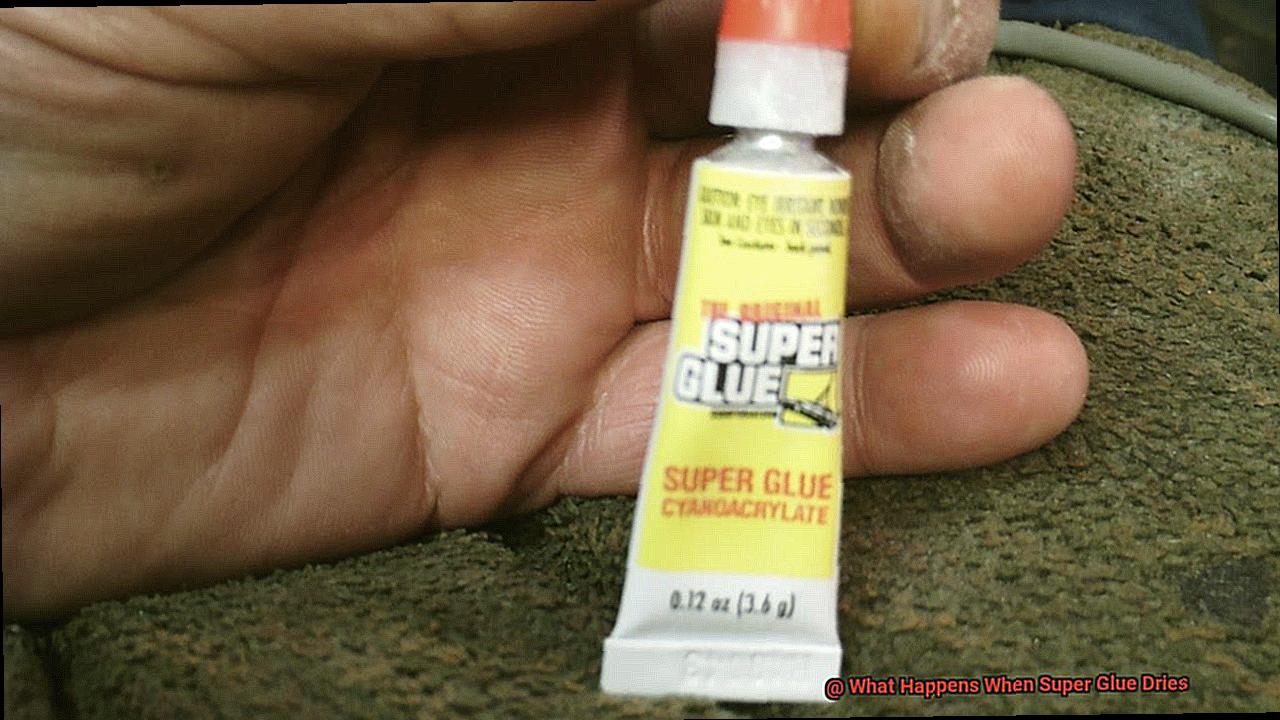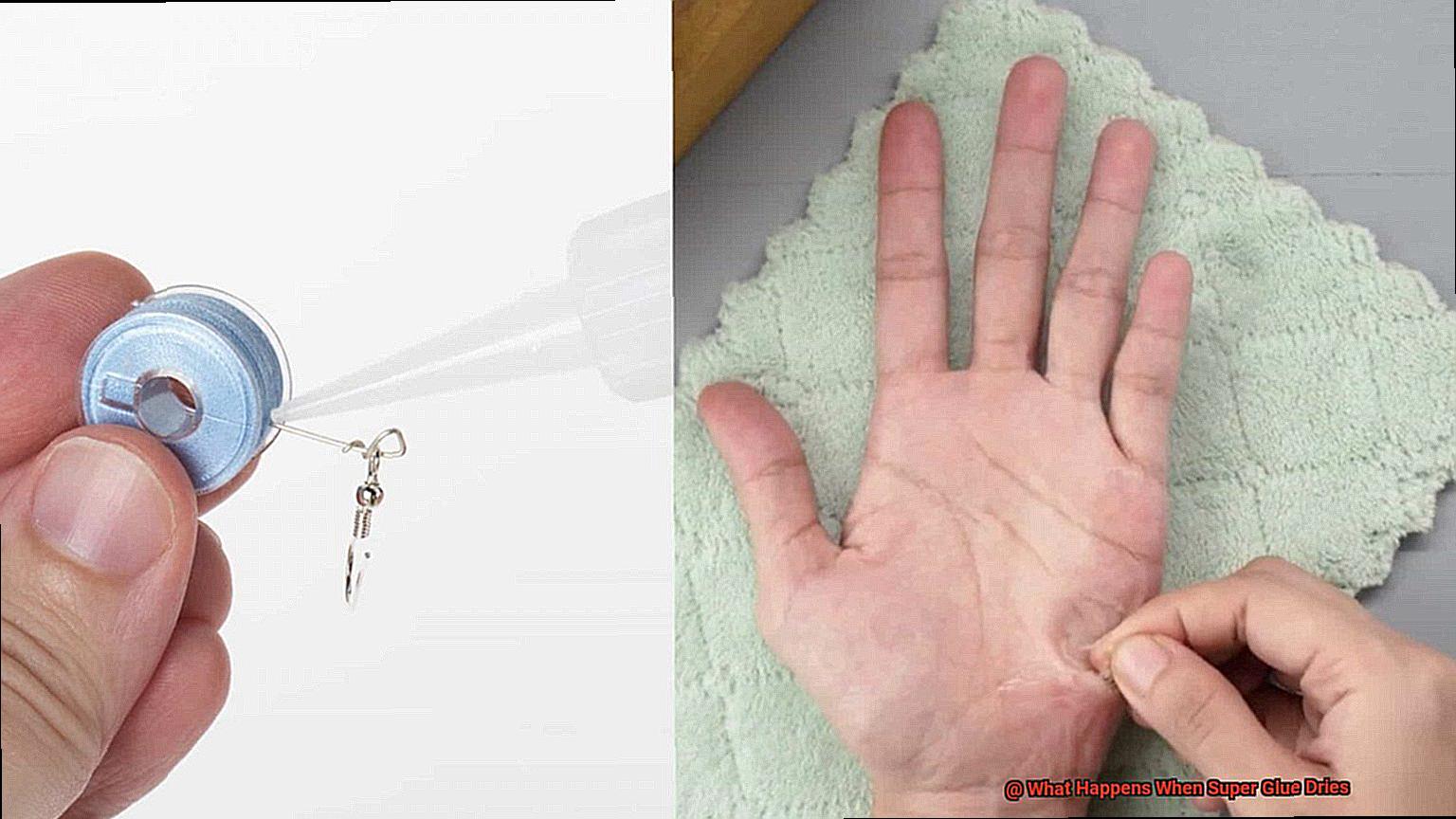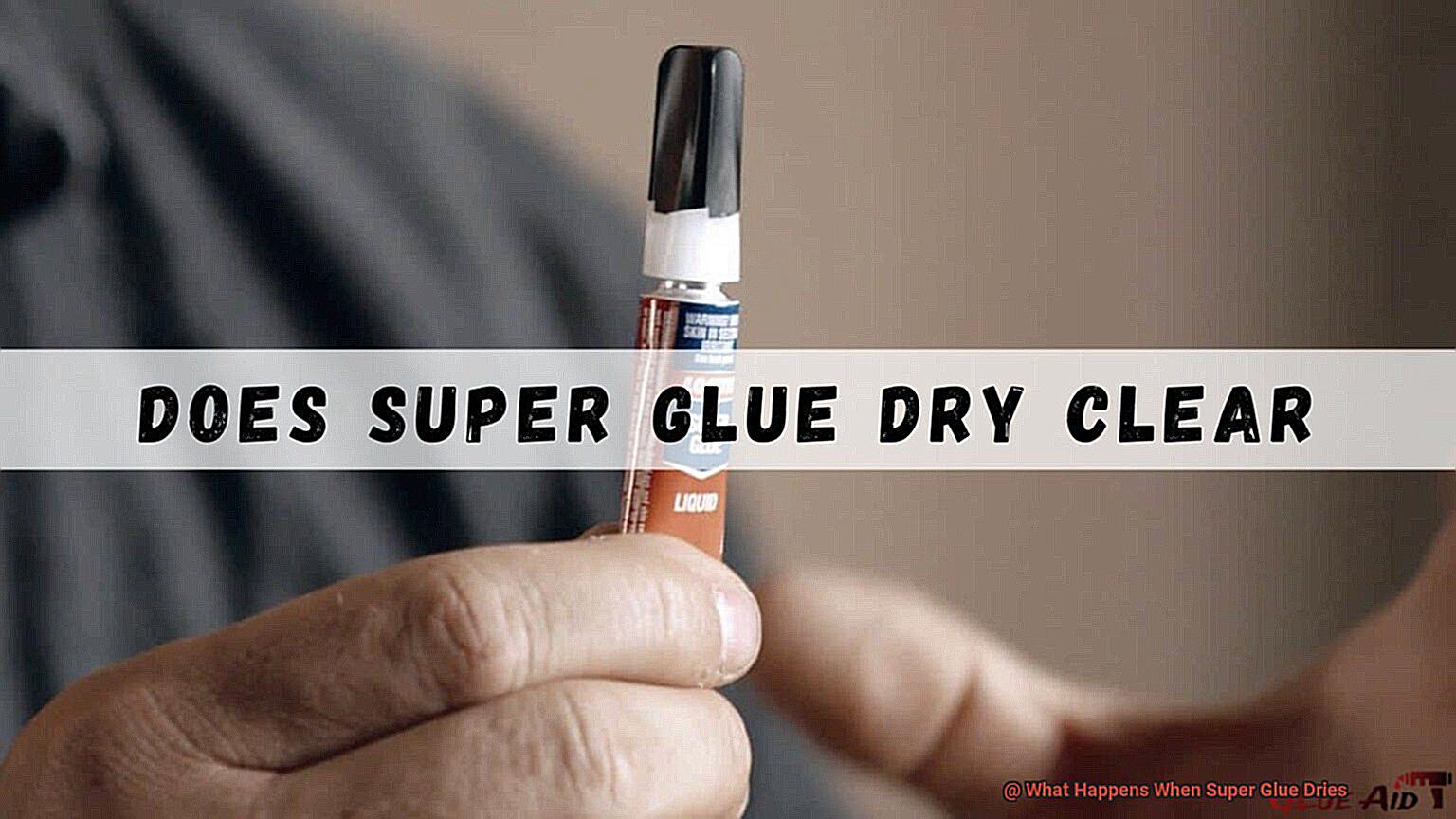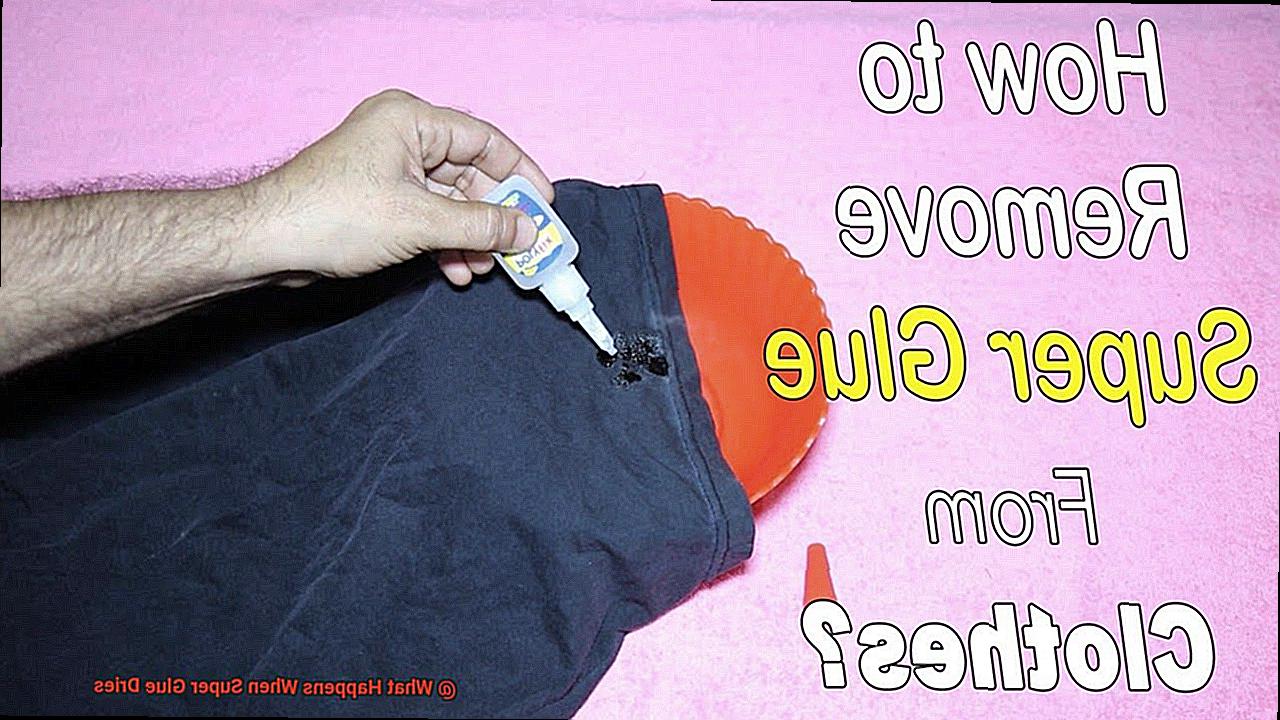Ever been stuck in a sticky situation? We’ve all been there, my friend. Whether it’s patching up a shattered vase or rescuing your favorite kicks from the brink of destruction, super glue has always been our trusty sidekick. But have you ever wondered what sorcery occurs when that gooey goodness morphs into an unbreakable bond? Get ready to embark on an epic adventure as we uncover the science behind what happens when super glue dries.
In the realm of adhesives, super glue reigns supreme with its mind-boggling ability to fuse different materials at lightning speed. It may seem like a humble substance at first glance, but beneath that glossy surface lies a chemical dance that gives birth to its extraordinary powers.
As we dive deep into the nitty-gritty of super glue drying, prepare to witness the secrets behind its legendary grip, unravel the mystical reactions occurring during the drying process, and explore the factors that shape its overall performance. By the time we’re done here, you’ll have a newfound appreciation for the scientific wizardry that turns a runny liquid into an unyielding fortress.
So, strap yourselves in and brace for an enthralling journey through the captivating world of super glue drying. Together, we’ll demystify this miraculous transformation and emerge with minds blown and curiosity satiated.

What is Super Glue?
Contents
- 1 What is Super Glue?
- 2 How Does Super Glue Work?
- 3 What Happens When Super Glue Dries?
- 4 The Drying Process of Super Glue
- 5 Factors That Affect the Drying Time of Super Glue
- 6 What Does the Cured Adhesive Look Like?
- 7 What Materials Can Be Bonded with Super Glue?
- 8 Removing Excess Super Glue from Unintended Surfaces
- 9 Conclusion
Super glue, or cyanoacrylate adhesive, has revolutionized the world of bonding materials together. Its fast-acting properties and incredible strength make it a staple in households and industries worldwide. In this article, we will explore the science behind super glue, understanding how it works and why it is so powerful.
The Drying Process:
Upon contact with air, super glue begins to dry almost instantly. This rapid drying is triggered by the presence of moisture, which initiates a chemical reaction with the glue. As the glue dries, it undergoes polymerization, where individual molecules join together to form long chains or polymers. This process gives super glue its incredible bonding strength.
Versatility in Bonding:
Super glue’s remarkable feature is its ability to bond a wide range of materials. It can repair broken items, craft intricate projects, and even be used in medical applications. It creates strong bonds between similar materials like plastics or metals, as well as between dissimilar materials such as plastic and wood.

Factors Affecting Drying Time:
Temperature and humidity play significant roles in how quickly super glue sets. Lower temperatures and higher humidity levels slow down the drying process, while warmer temperatures and lower humidity levels accelerate it. Additionally, the thickness of the applied layer can also impact drying time.
Curing Process:
While super glue dries quickly upon application, the curing process continues over time. This means that even after the initial drying period, the bond will continue to strengthen over several hours or days. It is crucial to allow sufficient time for the adhesive to fully cure before subjecting it to stress or load.
Safety Precautions:
Super glue is a powerful adhesive that must be handled with care. Working in a well-ventilated area is recommended to avoid inhaling fumes. Avoiding contact with skin and eyes is crucial since super glue can bond surfaces together. If accidental contact occurs, soaking the affected area in warm, soapy water or using acetone-based nail polish remover can help remove the glue.
How Does Super Glue Work?
In this article, we will delve into the captivating world of super glue and uncover the scientific mechanisms behind its ability to create strong and durable bonds in an instant. Get ready to be amazed as we explore the fascinating science behind this everyday adhesive.
Composition:
Super glue, scientifically known as cyanoacrylate adhesive, is composed of a liquid monomer called cyanoacrylate. This remarkable monomer possesses a unique characteristic—it polymerizes rapidly upon contact with moisture.
Polymerization Process:
When super glue is applied to a surface, the magic begins. The presence of even a trace amount of moisture triggers the polymerization process. As the cyanoacrylate monomers come into contact with moisture molecules, they undergo a swift chemical transformation, linking together to form long chains of interconnected molecules. This metamorphosis from liquid to solid occurs within mere seconds, creating an unyielding and inflexible bond.
Multiple Points of Contact:
The strength of the bond created by super glue lies in the intricate network of interconnected molecules. These chains intertwine and create multiple points of contact, fortifying the bond and making it incredibly difficult to break. It’s like a tightly woven web that holds everything together with unwavering strength.
Versatility:
Super glue’s versatility is nothing short of astonishing. It can bond an array of materials, including metal, plastic, rubber, ceramic, and even skin. Its low viscosity allows it to seep into every nook and cranny, ensuring a secure and lasting bond. From fixing broken household items to sealing wounds in emergency situations, super glue has become a go-to adhesive for countless applications.
Surface Preparation:

To unlock the full potential of super glue, proper surface preparation is crucial. Clean and dry surfaces provide an optimal environment for bonding, as any presence of dirt, oil, or moisture can impede the polymerization process. By meticulously preparing the surfaces beforehand, you pave the way for a bond that will stand the test of time.
What Happens When Super Glue Dries?
Today, we embark on a journey to unravel the fascinating process that occurs when super glue dries, unveiling its remarkable strength and durability.
The Polymerization Process:
Super glue initiates a chemical reaction called polymerization when it comes into contact with air. Moisture present in the air triggers this reaction, causing the cyanoacrylate molecules in the glue to join together and form long chains of polymers. These interlocked chains create a solid and rigid structure, transforming the once sticky liquid into an incredibly strong and unyielding adhesive.
The Stages of Drying:
When super glue dries, it progresses through distinct stages. Initially, it becomes tacky and sticky, allowing for easy adhesion to surfaces. This crucial stage, known as the “working time,” enables precise positioning and alignment of materials. Gradually, the glue hardens, losing its stickiness and solidifying into a robust material that resists manipulation or repositioning.
Drying Time:
The drying time of super glue varies depending on factors such as temperature, humidity, and application thickness. Thankfully, you won’t have to wait long for your project to dry – super glue typically takes only seconds to minutes to dry completely.
Strength and Durability:
Once dried, super glue forms an indomitable bond that is difficult to break. It withstands moisture, heat, and most chemicals, making it ideal for a wide range of applications. Whether you’re repairing broken ceramics or crafting intricate jewelry pieces, super glue ensures your creations endure the test of time.
Removal Challenges:
While super glue creates an immensely strong bond, removing it can present challenges. Acetone or nail polish remover can dissolve the glue, but caution must be exercised when using these solvents on delicate surfaces. Always test a small area first to avoid damaging the material.
The Drying Process of Super Glue
Prepare to embark on a captivating journey into the realm of glue. Today, we delve into the enigmatic drying process of super glue, exploring the intricate chemistry behind its remarkable bond formation. Brace yourself for a voyage filled with scientific marvels, chemical reactions, and a hint of enchantment.
So, what unfolds when super glue dries? It all revolves around a phenomenon known as polymerization. When exposed to the moisture in the air, super glue undergoes a magical transformation. Its molecules intertwine, forming long chains that metamorphose the liquid adhesive into an unyielding solid state. Astonishingly, this metamorphosis transpires within a matter of seconds. A feat of rapidity that defies belief.
But what precisely occurs during this polymerization process? The moisture in the air acts as a catalyst, triggering a chain reaction that breaks down the cyanoacrylate molecules and initiates the transformation. As the glue dries and solidifies, it creates an indomitable bond between the surfaces it embraces. This bond exhibits unparalleled resilience against moisture, temperature fluctuations, and even vibrations. Super glue reigns supreme as the adhesive par excellence.
Now let us delve into intriguing factors that can influence the drying time of super glue. The amount of glue applied is a critical factor – greater quantities result in longer drying times. Furthermore, different surfaces exhibit varying characteristics. Porous surfaces possess the ability to absorb moisture, thereby potentially prolonging the drying process. And let us not overlook the impact of humidity. High humidity can expedite drying time, while low humidity can impede it.
Sometimes, a little nudge is needed to hasten the drying process. Enter accelerators or activators – magical concoctions imbued with chemicals that interact with cyanoacrylate and catalyze faster polymerization. A turbocharge for your glue, if you will.
Now that you possess profound knowledge of super glue’s drying process, it is time to unleash its formidable strength. Remember to cleanse and dry the surfaces you wish to bond before applying the glue. Contaminants or moisture can disrupt the drying process and weaken the bond. Once the bond is forged, it endures indefinitely. Super glue creates a transparent, unyielding substance that resists water, solvents, and most chemicals. Whether mending fractured objects, bonding materials, or even engaging in medical pursuits, super glue never falters – it is your unwavering ally.
Factors That Affect the Drying Time of Super Glue
I have delved into the depths of glue knowledge to uncover the secrets behind the drying time of super glue. So sit back, relax, and prepare to be amazed by the factors that can affect how quickly your super glue sets.
First up, let’s talk about the type of super glue you’re using. Did you know that different formulations of super glue can have varying drying times? Some glues are specially designed for rapid drying, while others may take a bit longer to set. So make sure you check the label before making your purchase.
Now, let’s consider the environment in which you’re using your super glue. Temperature and humidity play a crucial role in the drying process. Super glue loves warmer temperatures and low humidity levels. So if you’re working in a chilly room or a damp environment, you might find yourself waiting a bit longer for that bond to form.
The material you’re bonding also matters. Porous materials like wood or fabric can absorb some of the moisture from the glue, which can slow down drying time. On the other hand, non-porous materials like metal or glass allow the glue to dry more quickly. So keep this in mind when choosing your adhesive surface.
The thickness of the bond being formed is another factor to consider. Thin layers of super glue dry much faster than thick ones. So be sure to apply thin, even coats for quicker drying and optimal bonding.
How you apply the super glue can also make a difference. Applying small drops or thin lines allows for better air circulation and faster evaporation, leading to quicker drying. On the flip side, slapping on a large amount of glue at once or in a thick layer may prolong the drying process.
Lastly, don’t forget about the quality and brand of super glue you’re using. Higher-quality glues often contain additives and accelerators that promote faster curing times. So investing in a reputable brand can save you time and frustration.
And let’s not forget about the importance of proper curing time. Although super glue may appear dry on the surface, it is essential to allow it sufficient time to fully cure. While the initial drying time may be relatively quick, complete curing can take several hours or even days, depending on the specific glue and bonding conditions. So be patient and follow the manufacturer’s instructions for optimal results.
What Does the Cured Adhesive Look Like?
Well, wonder no more. Let’s take a closer look at the appearance of a cured adhesive and all its glorious details.
When super glue dries, it goes through a magical transformation from a runny liquid to a solid state, resulting in the formation of a cured adhesive. And guess what? This cured adhesive is usually transparent or translucent, making it nearly invisible once it’s dried. How cool is that? You can discreetly repair items without worrying about any unsightly residue.
But hold on, not all super glues dry completely clear. Some formulations may have a slightly yellowish or amber tint after curing. Don’t panic though. It’s usually not too noticeable, especially if you’re bonding darker surfaces. But just to be safe, it’s always a good idea to test the glue on a small area first.
Now let’s talk texture. The cured adhesive can range from rigid and firm to slightly flexible or even rubbery, depending on the specific brand and formulation used. So if you’re looking for that extra bit of flexibility, make sure to choose the right super glue for your needs.
And finally, the finished product usually has a smooth and glossy finish, giving your bond that polished look. But beware of applying too much glue. Excess adhesive can lead to irregularities and mess up that smooth surface you’re aiming for.
What Materials Can Be Bonded with Super Glue?
This remarkable substance, also known as cyanoacrylate adhesive, possesses an extraordinary ability to bond a wide range of materials. From plastic and metal to wood and fabric, super glue can work wonders in joining different surfaces together. In this article, we’ll explore the diverse world of materials that can be bonded with super glue.
Plastic and Metal:
Super glue effortlessly adheres to various types of plastic, making it ideal for mending broken toys, household items, or even car parts. Whether it’s rigid plastic or flexible plastic, this adhesive is your secret weapon for seamless repairs and strong bonds. Additionally, metal surfaces such as aluminum, steel, and copper can also benefit from the bonding prowess of super glue. However, remember to clean oily or dirty metal surfaces before applying the adhesive for optimal results.
Wood and Rubber:
Woodworkers rejoice. Super glue is an excellent option for joining wooden pieces together securely. Perfect for intricate woodworking projects or quick fixes around the house, this adhesive creates a bond that is as strong as oak. Additionally, if you need to repair rubber soles on your favorite shoes or bond rubber gaskets or seals, super glue is the answer. It forms a reliable bond that can withstand wear and tear.
Ceramic, Glass, and More:
The beauty of super glue lies in its versatility. It can bond delicate ceramic and porcelain items like vases or mugs with ease. Glass materials can also be joined together using this mighty adhesive; just keep in mind that it may work better on rough or textured glass surfaces compared to smooth ones. Furthermore, fabrics and textiles can be swiftly repaired using super glue, making it an invaluable tool for fashion emergencies or crafting endeavors. And let’s not forget about leather, paper, cardboard, and many other common materials that can also be bonded effortlessly with super glue.
Special Considerations:
While super glue can bond a wide variety of materials, it’s important to consider certain factors for optimal results. Make sure to clean and prepare the surfaces properly before applying the adhesive. Smooth surfaces may require roughening or scoring to enhance the bond. Additionally, temperature and humidity can affect the curing time of super glue, so ensure that the environment is suitable for bonding.
Removing Excess Super Glue from Unintended Surfaces
Super glue, also known as cyanoacrylate adhesive, is a powerful and fast-acting adhesive that forms an incredibly strong bond when it dries. Accidents happen, and sometimes super glue ends up on unintended surfaces like skin, fabric, or household items. Removing excess super glue can be challenging, but with the right techniques and products, it is possible to effectively remove the glue without causing damage.
- Act quickly: The longer the glue has had to dry, the more difficult it will be to remove. Don’t waste any time in tackling the issue.
- For skin: Soak the affected area in warm soapy water to loosen the bond. Gently try to separate the glued skin with a twisting motion. If necessary, use acetone-based nail polish remover or rubbing alcohol to dissolve the glue. Be cautious with certain surfaces such as plastics or painted surfaces as acetone may cause damage.
- For fabric: Place the affected area in a plastic bag and freeze it for a few hours. Scrape off the dried glue gently with a blunt object like a spoon or credit card. Treat any remaining residue with acetone or rubbing alcohol, testing them first on an inconspicuous area of the fabric.
- For household items: Use a plastic scraper or credit card to lift off as much dried glue as possible without scratching the surface. Treat any remaining residue with acetone or specialized glue remover, testing them first on a small hidden area.
Seek professional help or consult manufacturer recommendations for delicate or sensitive surfaces.
EEEbKhnwpG0″ >
Conclusion
When super glue dries, it undergoes a fascinating transformation. As the adhesive evaporates, the liquid becomes a solid, creating an unbreakable bond. The once viscous substance hardens into a strong and durable material that can withstand immense pressure.
Once dried, super glue forms tight intermolecular bonds with the surfaces it is applied to. This results in a powerful grip that can hold objects together with incredible strength. Whether it’s fixing broken ceramics or securing delicate jewelry, super glue provides a reliable solution.
But it’s not just about strength; super glue also dries quickly. In a matter of seconds, you can witness its magical transition from liquid to solid. This rapid drying time makes it ideal for quick fixes and urgent repairs.
As the super glue sets, it forms a transparent and glossy finish. This seamless appearance ensures that your repaired items retain their original beauty and functionality. You won’t even know they were once broken.
However, it’s important to note that super glue is not invincible. While it may seem impenetrable once dried, extreme temperatures or excessive force can weaken its bond over time. So handle your glued items with care to ensure their longevity.
In conclusion, when super glue dries, it transforms into an unyielding and dependable adhesive that binds materials together tightly. Its quick drying time and transparent finish make it an invaluable tool for various repair projects.






